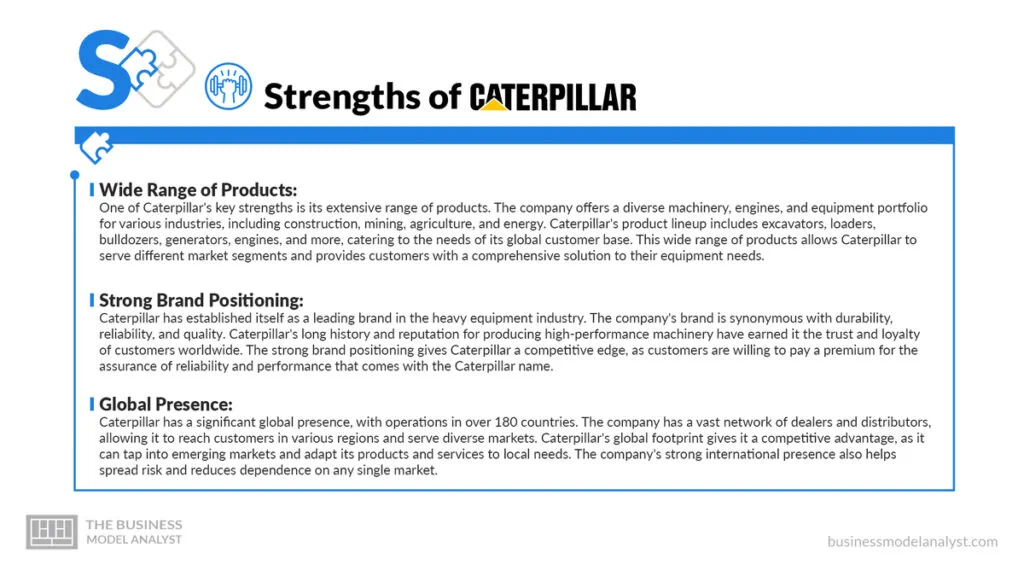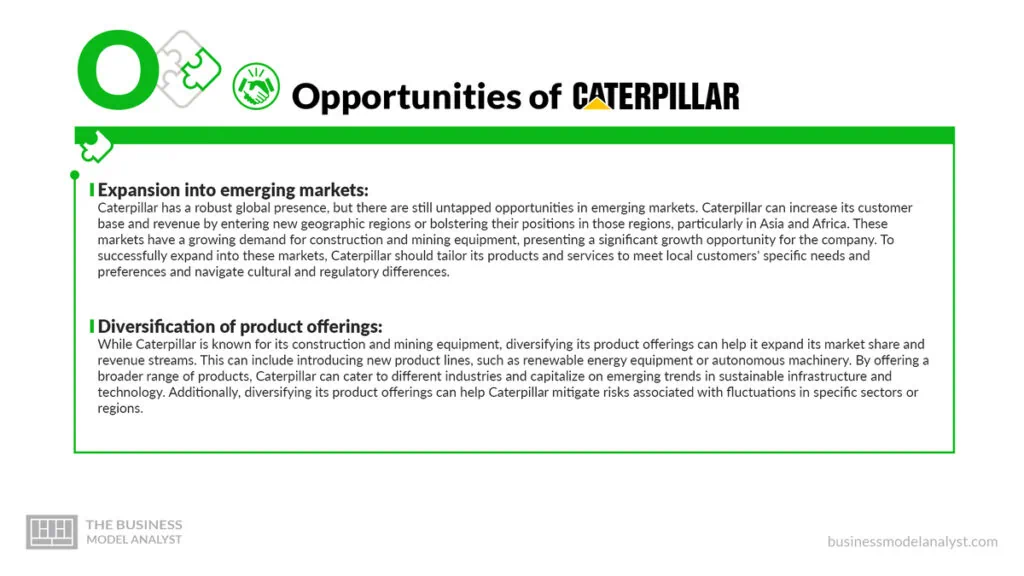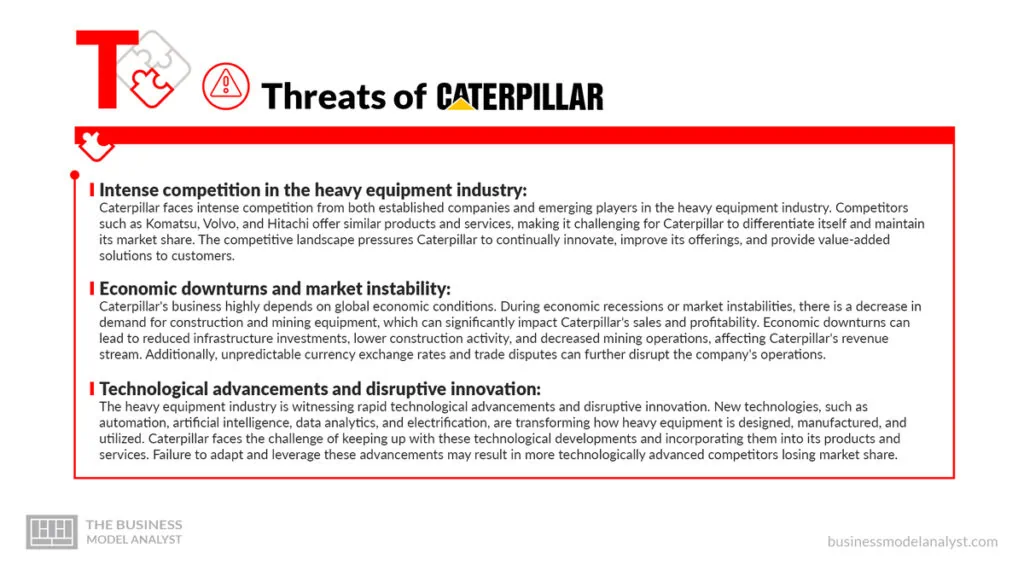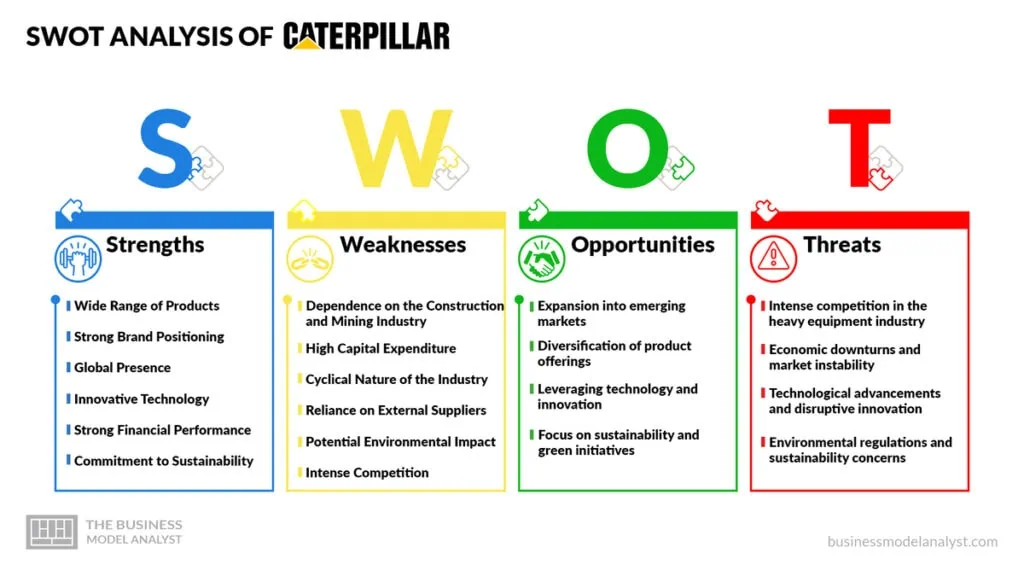Caterpillar, a renowned global manufacturing company, has dominated the industry for decades. With its extensive range of construction and mining equipment, as well as engines and power systems, Caterpillar has established itself as a trusted name in the market.
However, like any other company, Caterpillar has its own set of strengths, weaknesses, opportunities, and threats. In this Caterpillar SWOT analysis, we will thoroughly examine the company’s internal and external factors that affect its performance. By identifying and understanding these factors, we can gain valuable insights into Caterpillar’s current position and potential for future growth and success.
From its strong global presence to its extensive product portfolio, Caterpillar possesses several strengths that have contributed to its success. However, it also faces intense competition and changing market dynamics. By analyzing its weaknesses and threats, we can uncover areas Caterpillar can focus on improving and mitigating potential risks.
Contents
Caterpillar Strengths

Below, we will look at Caterpillar’s numerous strengths. The company’s strengths encompass a wide range of areas, including its diverse product portfolio, strong brand positioning, global presence, innovative technology, etc. These strengths are the pillars on which Caterpillar has built its success and continues to drive its position as a market leader.
Wide Range of Products
One of Caterpillar’s key strengths is its extensive range of products. The company offers a diverse machinery, engines, and equipment portfolio for various industries, including construction, mining, agriculture, and energy. Caterpillar’s product lineup includes excavators, loaders, bulldozers, generators, engines, and more, catering to the needs of its global customer base. This wide range of products allows Caterpillar to serve different market segments and provides customers with a comprehensive solution to their equipment needs.
Strong Brand Positioning
Caterpillar has established itself as a leading brand in the heavy equipment industry. The company’s brand is synonymous with durability, reliability, and quality. Caterpillar’s long history and reputation for producing high-performance machinery have earned it the trust and loyalty of customers worldwide. The strong brand positioning gives Caterpillar a competitive edge, as customers are willing to pay a premium for the assurance of reliability and performance that comes with the Caterpillar name.
Global Presence
Caterpillar has a significant global presence, with operations in over 180 countries. The company has a vast network of dealers and distributors, allowing it to reach customers in various regions and serve diverse markets. Caterpillar’s global footprint gives it a competitive advantage, as it can tap into emerging markets and adapt its products and services to local needs. The company’s strong international presence also helps spread risk and reduces dependence on any single market.
Innovative Technology
Caterpillar is at the forefront of technological innovation in the heavy equipment industry. The company invests heavily in research and development to develop advanced technologies and solutions that improve productivity, efficiency, and sustainability. Caterpillar’s focus on innovation has led to the introduction of cutting-edge features and capabilities in its machinery, such as advanced telematics, autonomous operation, and hybrid power systems. By continuously pushing the boundaries of technology, Caterpillar stays ahead of its competitors and meets the evolving needs of its customers.
Strong Financial Performance
Caterpillar has a strong financial performance track record, reflecting its ability to generate sustainable revenue and profits. The company’s financial stability results from its diversified product portfolio, global presence, and strong customer relationships. Caterpillar’s solid financial position allows it to invest strategically in research and development, expand its production capacity, and pursue growth opportunities. The company’s financial strength is also a testament to its operational efficiency and effective cost management.
Commitment to Sustainability
Caterpillar has demonstrated a solid commitment to sustainability and responsible business practices. The company has set ambitious sustainability goals, such as reducing greenhouse gas emissions and improving energy efficiency in its operations. Caterpillar incorporates eco-friendly features and technologies in its products, helping customers reduce their environmental impact. The company also focuses on employee safety and promotes diversity and inclusion in its workforce. Caterpillar’s sustainability initiatives enhance its brand reputation and attract customers who prioritize sustainability in their business operations.
Extensive Dealer Network
Caterpillar has an extensive dealer network, with dealerships located strategically worldwide. This network gives customers easy access to Caterpillar’s products, parts, and services. The company works closely with its dealers to ensure customer satisfaction and support, offering training programs, technical assistance, and aftermarket services. Caterpillar’s strong dealer network enhances its market reach and enables it to serve customers effectively, regardless of location.
Strong Customer Relationships
Caterpillar has a long history of building strong customer relationships based on trust, reliability, and support. The company strives to understand its customers’ needs and offers tailored solutions that meet their specific requirements. Caterpillar’s focus on customer satisfaction has led to long-term partnerships and repeat business. The company also provides extensive support services, including maintenance, repairs, and parts availability, ensuring that customers can rely on their Caterpillar equipment for optimal performance.
Caterpillar Weaknesses

In analyzing the strengths and weaknesses of a company, it is vital to assess the internal factors that may hinder its performance and growth. In the case of Caterpillar, several weaknesses can impact its overall competitiveness and market position. These weaknesses include the following:
Dependence on the Construction and Mining Industry
One weakness for Caterpillar is its heavy reliance on the construction and mining industry. The company’s core business revolves around providing machinery, equipment, and services to these sectors. As a result, any downturn or slowdown in these industries can significantly impact Caterpillar’s financial performance. Changes in construction and mining activities, such as reduced investments or project delays, can decrease demand for Caterpillar’s products and services. This dependence makes Caterpillar vulnerable to market fluctuations and economic downturns, limiting its ability to diversify its revenue streams.
High Capital Expenditure
Caterpillar’s operations are capital-intensive, requiring substantial investments in research and development, manufacturing facilities, and distribution networks. This high capital expenditure burdens the company and limits its ability to react quickly to market changes or invest in new growth opportunities. Moreover, the need for continuous investment in equipment and technological advancements to meet customers’ changing demands increases Caterpillar’s operating costs. The high capital expenditure also exposes the company to risks associated with overcapacity and excess inventory in times of reduced demand.
Cyclical Nature of the Industry
The construction and mining industry is highly cyclical, characterized by periods of prosperity and downturns. During economic downturns, construction projects are often delayed or canceled, reducing demand for Caterpillar’s products and services. This cyclicality can result in significant company sales and profitability fluctuations. Moreover, the industry’s cyclical nature makes it challenging for Caterpillar to forecast future demand accurately, plan production capacity, and manage its supply chain effectively. The company may face challenges balancing production levels during periods of high demand and reducing costs during downturns.
Reliance on External Suppliers
Caterpillar relies on a global network of suppliers to source raw materials, components, and parts for its products. This dependence exposes the company to risks such as supply chain disruptions, price fluctuations, and quality issues. Any disruption in the supply chain, such as natural disasters, political instability, or trade policy changes, can cause production delays and impact Caterpillar’s ability to meet customer demand. In addition, the company’s reliance on external suppliers may limit its control over the quality and reliability of the components used in its products. Any issues with the sourced materials can lead to product recalls or customer dissatisfaction, damaging Caterpillar’s reputation.
Potential Environmental Impact
The nature of Caterpillar’s business, particularly in the construction and mining sectors, has the potential for a significant environmental impact. Heavy machinery and equipment operation contributes to greenhouse gas emissions, energy consumption, and noise pollution. As sustainability and environmental regulations become increasingly stringent, Caterpillar may face challenges in meeting these requirements and improving its environmental performance. Failure to address these environmental concerns effectively could result in reputational damage, regulatory fines, and limitations on its ability to operate in specific markets.
Intense Competition
Caterpillar operates in a highly competitive industry, with numerous competitors, ranging from multinational corporations to local players. The company faces competition from construction and mining machinery manufacturers, as well as providers of related services and aftermarket parts. This intense competition pressures Caterpillar to continually innovate, improve efficiency, and differentiate its products and services. Competitors may offer similar or even superior products at competitive prices, potentially leading to Caterpillar’s loss of market share. The industry’s competitive landscape may also result in pricing pressure, lower profit margins, and increased marketing and promotional expenses.
Economic and Political Instability
Caterpillar’s global operations expose the company to various economic and political risks. Economic downturns, recessions, or currency fluctuations in key markets can impact the Company’s sales, profitability, and cash flow. Political instability, trade disputes, or changes in government policies and regulations can disrupt the Company’s operations, supply chains, and market access. To mitigate these risks, the company must constantly monitor and adapt to evolving economic and political conditions.
Aging and Obsolescence of Equipment
The long lifespan of Caterpillar’s machinery and equipment presents a challenge in terms of product obsolescence. Technological advancements and changing customer preferences can render existing products obsolete or less competitive. Customers may favor more advanced or efficient equipment competitors offer, leading to lower demand for Caterpillar’s products. The company must invest in research and development to develop new and innovative products that meet evolving customer needs and stay ahead of industry trends. Failure to keep up with technological advancements could result in declining market share and sales.
Caterpillar Opportunities

There are various opportunities that Caterpillar can leverage to further enhance its business and drive future growth. Caterpillar can identify untapped potential and capitalize on emerging opportunities by carefully analyzing the market landscape and industry trends. Some of these opportunities include:
Expansion into emerging markets
Caterpillar has a robust global presence, but there are still untapped opportunities in emerging markets. Caterpillar can increase its customer base and revenue by entering new geographic regions or bolstering their positions in those regions, particularly in Asia and Africa. These markets have a growing demand for construction and mining equipment, presenting a significant growth opportunity for the company. To successfully expand into these markets, Caterpillar should tailor its products and services to meet local customers’ specific needs and preferences and navigate cultural and regulatory differences.
Diversification of product offerings
While Caterpillar is known for its construction and mining equipment, diversifying its product offerings can help it expand its market share and revenue streams. This can include introducing new product lines, such as renewable energy equipment or autonomous machinery. By offering a broader range of products, Caterpillar can cater to different industries and capitalize on emerging trends in sustainable infrastructure and technology. Additionally, diversifying its product offerings can help Caterpillar mitigate risks associated with fluctuations in specific sectors or regions.
Leveraging technology and innovation
Technology is rapidly transforming the construction and mining industries, and Caterpillar can leverage innovation to stay competitive. Investing in research and development can lead to the development of new and advanced equipment, such as smart machinery with enhanced automation and connectivity features. By embracing digitalization and data analytics, Caterpillar can optimize equipment performance, improve productivity, and offer value-added services, such as predictive maintenance and remote monitoring. Furthermore, partnering with technology companies and startups can bring fresh ideas and accelerate innovation within the company.
Focus on sustainability and green initiatives
Sustainable practices and environmental consciousness are becoming increasingly important in the construction and mining industries. Caterpillar can position itself as a leader in sustainable solutions by developing eco-friendly equipment and processes. This can include reducing emissions, improving fuel efficiency, and promoting renewable energy sources. By embracing sustainable practices, Caterpillar can attract environmentally conscious customers, comply with stricter environmental regulations, and enhance its brand reputation.
Strengthening customer relationships and aftermarket services
Building strong customer relationships and providing excellent aftermarket services can drive Caterpillar’s customer loyalty and repeat business. This can include offering comprehensive maintenance and repair services, timely spare parts availability, and training programs for customers on optimizing the use of Caterpillar equipment. By investing in customer support and building long-term partnerships, Caterpillar can differentiate itself from competitors and establish a reputation for reliability and customer satisfaction.
Strategic acquisitions and partnerships
Caterpillar can leverage acquisitions and strategic partnerships to expand its capabilities, access new markets, and drive growth. Strategic acquisitions can help the company enter new industries or enhance its product portfolio. Partnerships with other businesses and organizations can also provide access to new technologies, distribution channels, and customer segments. By carefully evaluating potential acquisition targets and partners, Caterpillar can capitalize on synergies and gain a competitive advantage in the market.
Focus on digitalization and connectivity
Integrating digital technologies and connectivity features can transform how Caterpillar operates and delivers value to customers. By embracing the Internet of Things (IoT) and leveraging data analytics, Caterpillar can optimize equipment performance, improve operational efficiency, and offer innovative services, such as remote monitoring and predictive maintenance. Connected equipment can also enable Caterpillar to gather valuable insights on customer usage patterns and equipment performance, informing future product development and customer support initiatives.
Expansion of rental and leasing services
Caterpillar can further expand its rental and leasing services to provide flexible and cost-effective solutions to customers. This can include offering short-term rentals for seasonal projects or long-term leasing options for customers who prefer to avoid upfront capital expenditures. By expanding its rental and leasing offerings, Caterpillar can capture additional revenue streams and cater to customers with varying financial constraints or project requirements.
Exploration of new markets and applications
While Caterpillar has a strong presence in construction and mining, there may be opportunities to explore new markets and applications for its equipment. This can include industries such as agriculture, forestry, or marine. By adapting its equipment and services to suit the unique needs of these industries, Caterpillar can tap into new customer segments and diversify its revenue streams. Market research and analysis can help identify potential opportunities and validate the feasibility of entering new markets.
Focus on employee training and development
Investing in employee training and development can enhance Caterpillar’s capabilities and ensure a skilled workforce that drives innovation and operational excellence. By providing ongoing training programs and professional development opportunities, Caterpillar can attract and retain top talent, foster a culture of continuous learning, and stay at the forefront of technological advancements. Developing leadership and succession planning initiatives can also ensure the company’s long-term sustainability and maintain a competitive edge in the industry.
Caterpillar Threat

Below, we will highlight Caterpillar’s various threats in its business operations. Despite its strong market position and reputation, Caterpillar is not immune to challenges and risks that can impact its performance and sustainability. This analysis highlights the key threats the company must navigate to maintain its competitive edge and continue delivering value to its stakeholders.
Intense competition in the heavy equipment industry
Caterpillar faces intense competition from both established companies and emerging players in the heavy equipment industry. Competitors such as Komatsu, Volvo, and Hitachi offer similar products and services, making it challenging for Caterpillar to differentiate itself and maintain its market share. The competitive landscape pressures Caterpillar to continually innovate, improve its offerings, and provide value-added solutions to customers.
Economic downturns and market instability
Caterpillar’s business highly depends on global economic conditions. During economic recessions or market instabilities, there is a decrease in demand for construction and mining equipment, which can significantly impact Caterpillar’s sales and profitability. Economic downturns can lead to reduced infrastructure investments, lower construction activity, and decreased mining operations, affecting Caterpillar’s revenue stream. Additionally, unpredictable currency exchange rates and trade disputes can further disrupt the company’s operations.
Technological advancements and disruptive innovation
The heavy equipment industry is witnessing rapid technological advancements and disruptive innovation. New technologies, such as automation, artificial intelligence, data analytics, and electrification, are transforming how heavy equipment is designed, manufactured, and utilized. Caterpillar faces the challenge of keeping up with these technological developments and incorporating them into its products and services. Failure to adapt and leverage these advancements may result in more technologically advanced competitors losing market share.
Environmental regulations and sustainability concerns
Increasing environmental awareness and stringent regulations regarding emissions and sustainability threaten Caterpillar. As governments and customers prioritize environmental stewardship, there is a growing demand for eco-friendly and fuel-efficient equipment. Failure to meet these regulatory requirements or address sustainability concerns may result in lost customers, a negative brand image, and potential legal and financial liabilities. Caterpillar must invest in research and development to develop greener technologies and actively promote its commitment to sustainability.
Supply chain disruptions and raw material price volatility
Caterpillar’s global supply chain is vulnerable to disruptions caused by factors such as natural disasters, political instability, transportation issues, and labor disputes. Disruptions in the supply chain can lead to delayed deliveries, increased costs, and production bottlenecks, affecting Caterpillar’s ability to meet customer demand. Raw material price volatility, including fluctuations in steel, aluminum, and rubber prices, can also impact the company’s profitability. Caterpillar must have robust contingency plans in place, diversify its supplier base, and effectively manage raw material costs to mitigate these risks.
Changing customer preferences and industry trends
In the heavy equipment sector, Customer preferences and industry trends are constantly evolving. Factors such as changing infrastructure needs, demand for sustainable solutions, and the emergence of new construction techniques can impact Caterpillar’s product portfolio and demand patterns. Failure to anticipate and respond to these changing preferences and trends may result in a mismatch between Caterpillar’s offerings and customer expectations, leading to decreased market share and revenue.
Trade barriers and geopolitical uncertainties
Caterpillar operates globally and is exposed to trade barriers and geopolitical uncertainties. Tariffs, trade disputes, and political tensions between countries can disrupt the company’s supply chain, increase costs, and limit market access. Trade policy and regulation changes can lead to uncertainty in global markets, impacting customer confidence and investment decisions. Caterpillar must closely monitor geopolitical developments and diversify its market presence to minimize the impact of trade barriers and geopolitical uncertainties.
Conclusion
Caterpillar exhibits both strengths and weaknesses that impact its position in the global market. Its substantial brand value and extensive product portfolio provide a competitive advantage, while its international presence and technological innovations contribute to its market leadership. However, the company faces challenges related to economic uncertainties and fluctuations in product demand.
Caterpillar should leverage its strengths to capitalize on growth opportunities, such as expanding into emerging markets and diversifying its product offerings. By addressing its weaknesses and mitigating external threats, Caterpillar can enhance its overall market performance and maintain its position as a leading player in the industry.


